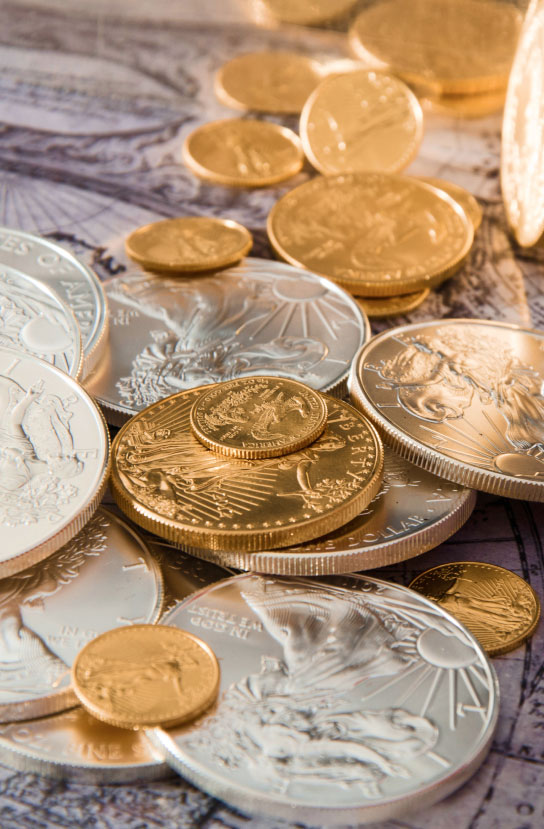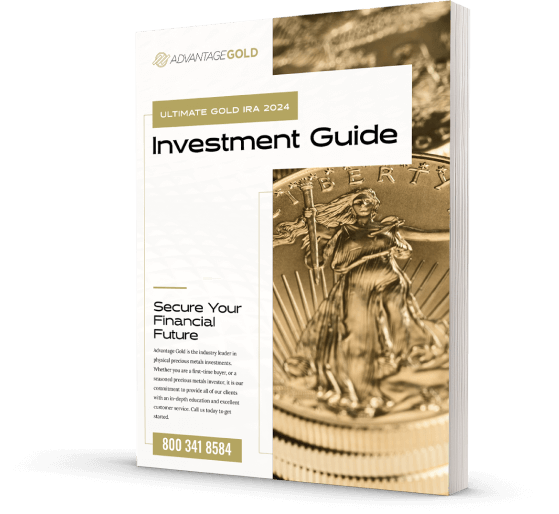IRA 101
Curious about IRAs and how they work? Explore the ins and outs of individual retirement accounts, including gold IRAs.
A gold self-directed individual retirement account (IRA), or precious metals IRA, is an IRA that includes IRS-approved precious metals, including gold, silver, platinum, and palladium. When you open a gold IRA account, an IRS-approved custodian holds the gold IRA’s contents for your benefit.
Gold IRAs function similarly to traditional IRAs with one exception: Instead of buying paper assets, you buy and own physical assets: coins and bars. Even though other precious metals may be present in a gold IRA, we refer to these retirement accounts as gold IRAs because gold is typically the most common precious metal in these types of accounts.
When you choose a self-directed IRA with Advantage Gold, we’ll help you choose which precious metal coins and bars make the most sense for you and your goals. Learn more about what a gold IRA is here.

Conventional IRAs or 401(k) accounts from financial advisors, banks, or brokerage firms can limit what you can invest in or what changes you can make. This isn’t the case with a self-directed IRA. In addition, investing in gold and other precious metals can help you hedge against inflation. Having gold in your portfolio can even reduce your overall risk, especially in the face of stock market downturns.
If you’re new to the idea of self-directed IRAs or holding physical gold, you probably have a few questions. The following information can help you start investing in physical gold.
Before you sit down to buy gold as part of any precious metals IRA, you need to understand the basic rules. These include the types of accounts—either traditional or Roth options—available.
The process of purchasing physical precious metals differs from buying gold stocks or exchange-traded funds (ETFs). All IRS-approved gold and silver must meet specific IRS fineness standards. They also need to be stored in an IRS-approved depository—not a safe deposit box or in your home. The same is true for platinum and palladium.
In addition to metal-specific rules, all gold IRAs are subject to the rules regarding tax advantages: because they’re a liquid investment, taking physical possession of your gold counts as withdrawing from your retirement fund. You’ll have to pay all associated taxes and fees, including early withdrawal penalties.
You have many choices when selecting a reputable gold IRA company. In general a gold IRA company should offer competitive prices, excellent customer support, and transparent pricing.
We recognize that meeting your retirement goals is the key to a solid financial future. Advantage Gold is one of the top gold IRA companies in the industry.
When you choose to work with us, you have access to some of the best customer service in the business. We have built relationships with established custodians that have a fantastic track record from the Better Business Bureau and the flexibility to help you meet your specific retirement diversification goals.
Buying gold and other IRA precious metals is simple. You may roll over an existing retirement account (IRA, 401k, TSP, pension) to your self-directed IRA. Because you’re rolling the funds over, you won’t be subject to any taxes on the move if the funds remain in a qualified plan.
Another option is to transfer cash into the self-directed gold IRA to fund your purchase. These deposits must follow the annual IRA contribution limits. You may purchase gold bars, coins, or other precious metals.

Please note that Advantage Gold and its representatives are not licensed or registered investment advisers, attorneys, CPA’s or other financial service professionals. We do not offer or render any legal, tax, accounting, investment advice or professional services. Additionally be aware that precious metals carry risk of loss and are not a suitable investment for everyone. Past performance is not necessarily indicative of future results and you should always consult your financial and tax professional and carefully evaluate all risks associated with the acquisition of precious metals before making the investment.
The statements made on this website are opinions of Advantage Gold LLC. Past performance is not necessarily indicative of future results. Precious metals, Gold American Eagles, Proof Gold American Eagles, certified gold coins, as well as gold and silver bars carry risk and investing in precious metals directly or through an IRA is not suitable for all investors. Precious metals and coins (i.e. Canadian Gold Maples, Canadian Silver Maples, American Gold Eagles, American Silver Eagles, Proof Gold American Eagles, Proof Silver American Eagles, Certified Gold American Eagles, Numismatic Gold Coins) may appreciate, depreciate, or stay the same depending on a variety of factors. Precious metals can and will fluctuate unexpectedly. Advantage Gold cannot guarantee, and makes no representation, that any metals purchased (i.e. .999 gold bars, .9999 silver bars, or any gold coins) will appreciate at all or appreciate sufficiently to produce a profit above and beyond the mark up/ commissions charged whether they are bought for direct delivery or inside of a precious metals IRA. The decision to purchase or sell precious metals with cash or inside of a Gold IRA or a Gold Backed IRA, and which precious metals to purchase or sell, are the customer’s decision alone, and purchases and sales should be made subject to the customer’s own research, prudence and judgment. By accessing any Advantage Gold content, you agree to be bound by the terms of service. Review the terms of service and privacy policy.
*Consult your tax Advisor.